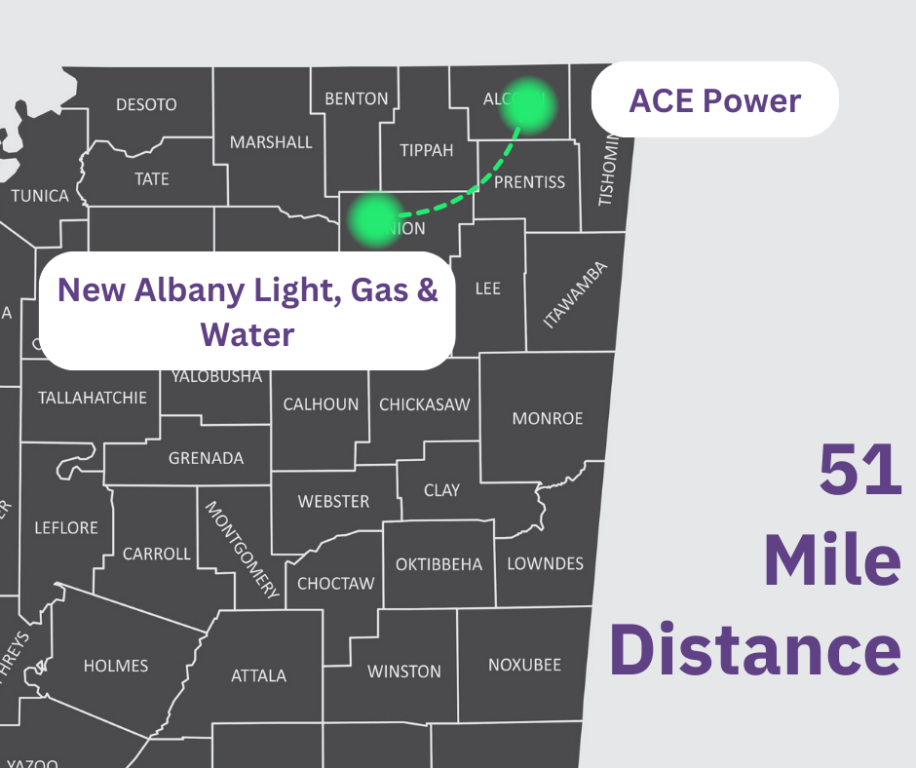By Bruce Smith, CEO at GEOGRAPH
Over the last few years, quality broadband services have become a top priority in the US. Currently, 51% of US homes have access to Fiber Optic Networks (Fierce Telecom) compared to just over 30% in 2020. This increase in broadband coverage can be attributed to many new players entering the market, with Rural Electric Cooperatives now becoming involved. Their instant access to customers and existing infrastructure make this group a likely choice for quick fiber network deployment.
With all the good news surrounding fiber deployments, municipalities and cities that maintain their own public utilities are often limited legally in their ability to deploy commercial services like broadband. In this blog post, I’ll be sharing a recent conversation with Sean McGrath, CEO of Alcorn County Electric (ACE Fiber, an ACE Power Network). I met Sean as GEOGRAPH was helping ACE Power with their network planning and design, and together we explore their journey into broadband internet service and their budding partnership with the City of New Albany, Mississippi (The City of New Albany, MS) to bridge the digital divide to over 10,000 New Albany residents.

It Takes a Village
The quote, “Individually we are one drop, but together we are an ocean,” by Ryunosuke Satoro perfectly captures the power of collaboration.
In my nearly 30 years in the industry, I have witnessed firsthand the collective effort it will take to connect 131 million US households (Statista). The traditional method that dominated the first half of the 20th century would not sustain this kind of growth initiative today. The days when the Power Company provided power, the telephone company provided voice and data, and the Cable company provided TV are over.
This way of thinking would still have the US at a disadvantage when it comes to high-speed internet. Thankfully, the Communications Act of 1996 (Telecommunications Act of 1996) changed this way of thinking and allowed more players to enter the field of broadband. Deregulation allowed cross-discipline utilities to enter into the broadband market. This also allowed for commercial entities to enter the market that for the previous 100 years had been airtight to competition.
Since the deregulation of communications networks, Rural Electric Cooperatives have been slowly venturing into the market. Visionary leaders recognized that the biggest obstacle to building broadband networks is the cost of labor and materials of the infrastructure and attracting customers. Electric Cooperatives already had significant infrastructure in place with hundreds and thousands of miles of pole line. They also had access to the customer. This made them perfectly positioned to become key players in the broadband expansion.
Even with deregulation and expansion from the cross-discipline utilities, there were still some regulations in place for public institutions like municipalities, city and state governments. Unlike private companies, they were restricted from creating for-profit utilities. This meant residents in these areas remained dependent on the existing internet service providers, limiting their choices.
This is where the partnerships between public and private utilities can work together to continue closing the digital divide. Below are excerpts from my conversation with Sean McGrath about their journey into the broadband market and their expansion partnership with New Albany Light, Gas & Water.
The Beginning of ACE Fiber
In 2017, ACE Power Networks was approached by the Northern District Public Service Commission of Mississippi about the idea of building rural broadband on their system. The ACE leadership left the meeting with mixed feelings. Sean asked his boss, Eddie Howard, the CEO of ACE at the time, “Have you ever been happy with your internet provider?” To which Eddie answered, “No.” Sean then commented, “Why in the world would we want to get into that business then?”
This sentiment is often echoed by many. No one is ever “happy” with their internet provider. ACE Power Networks’ mission statement is to provide affordable reliable electricity, so taking on a service that could jeopardize that mission was daunting.
Two years later, in 2019, the Mississippi Legislature passed the Broadband Enabling Act (Mississippi Broadband Enabling ACT). This prompted ACE to develop a plan to enter the broadband market. After three independent feasibility studies and one internal study, ACE created a business plan and started building fiber as a way to diversify its revenue streams. ACE looked at this diversification as a way to subsidize their electric service and keep affordability at the forefront of their mission.
When asked if the initiative was successful, Sean commented “wildly successful,” and below are the reasons he considers it that way:
- Take rate: In the business plan, ACE anticipated topping out at a 50% take rate within 20 years. They hit 52% in the first four years.
- Community involvement: As the incumbent local electric provider, ACE did not have to “market” to their customer base because there was no competition. Therefore, they did not participate in community events or do many local sponsorships. Now that ACE is in the competitive broadband market, they have had to learn to connect better with their customers and market at a different level than ever before.
The Challenges
- Launching during COVID
ACE Fiber was launched in 2020 during the COVID pandemic. Not only did ACE have to learn a new network and business model, but they also had to do it during the height of a nationwide pandemic. Working with consultants, contractors, and staff to build a large-scale fiber network with social distancing, and working from home, created added pressure.
- Bleeding Edge Technologies
Outside of the global supply chain issues, ACE was also venturing into new and evolving technologies. ACE chose to launch with XGS PON technology (Adtran XGS PON). This technology was still relatively new and immature and ACE was one of the first organizations in the country to be deploying this technology. ACE along with their access partner ADTRAN were able to grow through these challenges and complete a next-generation 10 Gig network.
- Learning a New Regulatory Environment
ACE Power has been in the power industry for nearly 90 years and is the region’s trusted energy provider. Sean said, “We know how to do customer service pretty well, and that is what we hung our hats on. We took for granted that it would be easy to be a broadband operator.” ACE quickly realized the challenges in participating in FCC funding options and regulations, along with the necessity to stay on top of the rapidly changing environment that broadband service brings.
Developing the Relationship with New Albany Light, Gas & Water
It all starts with relationships.
New Albany Light, Gas & Water planned to build fiber infrastructure to connect its electric facilities and envisioned building it so that it could lease facilities to a network operator. An employee at New Albany had a long-time relationship with Sean and the folks at ACE Power and made the introductions.
Mississippi municipalities cannot operate as broadband network operators but they can build and own facilities. New Albany had been reaching out to operators to offer leases to the facilities, but with little interest. However, after meeting with ACE, they recognized the synergies to work together. The interesting part was the synergies and relationship made the partnership a good fit, even though ACE is not contiguous to New Albany. In fact, they are about an hour away from one another.
Within a few weeks, ACE and New Albany put together a business plan, and both parties continued to realize the value of the diversified revenue stream and stay true to their mission to keep electric rates low.
Public-Private Partnership Challenges

ACE planned to offer the same excellent broadband service to New Albany residents as their existing customers. Taking on this change meant they would need warehousing, customer service offices, and a presence in the area. Being over an hour away from New Albany added cost and time to ACE. This also meant that they needed to secure exclusivity with New Albany on the network so the investment in operations would be well-spent. In the end, ACE secured a long-term exclusivity partnership with New Albany that benefited both parties as more customers were added. This created a true partnership with mutual risk and rewards for both parties.
ACE Fiber also had to adjust to expectations regarding timing and decision-making. As a private cooperative, ACE could make decisions quickly. This is not how things happen at a Public Institution because public policies make decisions at a much slower pace. Bringing items before councils, the need for group approvals, and procurement laws all slowed action down.
Lessons Learned
When ACE began building its fiber network, it was at the mercy of consultants who directed the build. The opportunity to begin again in a new market meant they could take the lessons learned through the initial growing pains and improve those in the New Albany network alongside working with GEOGRAPH for their network planning and design.
- Focus on Core Network
One of those was starting slow to go fast. ACE wanted to take time to learn about the New Albany electric network so they could best plan the core network for New Albany. They did not focus on this early with their build, and they had to make adjustments along the way to strengthen and reinforce their core network. By understanding the infrastructure and the area’s layout, ACE could make sure that providing a strong redundant core network is a priority.
- Mature Network Components
ACE realized numerous small lessons as well, like MST and Drop distances. During their build, they noticed more maintenance issues with longer tails and drops. Therefore, they could better dictate these parameters in the new designs.
- Design and Planning
Lastly, the XGS Pon technology is more advanced now and ACE is more familiar with it. This means that the residents of New Albany will be provided with one of the best-planned and thought-out networks with the latest technology for superior service.
What’s Next?
As noted earlier, the partnership between ACE and New Albany began through existing relationships. When asked if ACE would expand and do this again, Sean joked and said, “I’ll never say never.” ACE has experienced the pitfalls and learning curves of building broadband networks, and they have been able to take those lessons and improve on them with the New Albany partnership.
Still, Sean also knows the value of like-minded people it takes to achieve such initiatives. That means ACE will not likely jump into opportunities lightly. When asked what one piece of advice he would give to others looking at venturing into the broadband industry or venturing into a Public-Private partnership, Sean said, “Find the right fit for your organization. Find projects that fit within your mission, and find partners that fit what you do.”
A big thank you to Sean for sharing his story of how the ACE partnership with New Albany came to fruition and paved the way for public-private partnerships in the broadband industry! You can learn more about ACE Power, ACE Fiber, and New Albany Light, Gas & Water.

Bruce Smith is CEO at GEOGRAPH and he began his career building copper and fiber networks over 25 years ago. He has overseen the construction of more than 10,000 miles of network improvements and he has designed, engineered, and managed projects and installations throughout the United States. Since June of 2018, Bruce has been at the helm of GEOGRAPH and has worked to establish a world-class organization focused on customer success. Today GEOGRAPH supports over 160 customers in 38 of the United States and in Canada, the British Virgin Islands, Bermuda, Guam, and Guyana.




